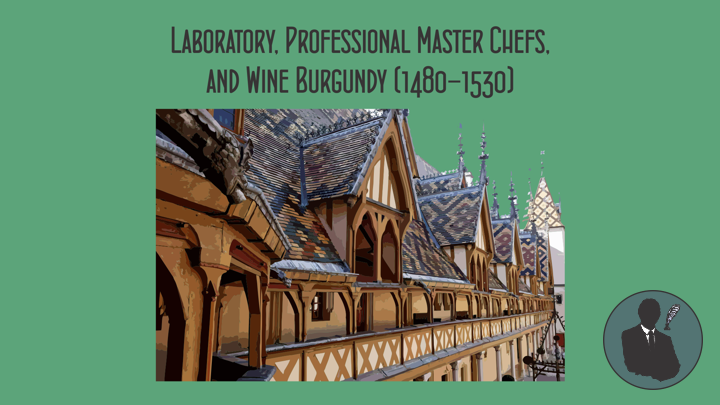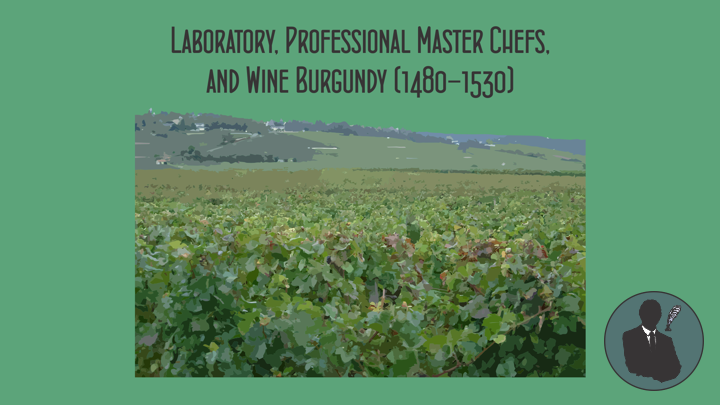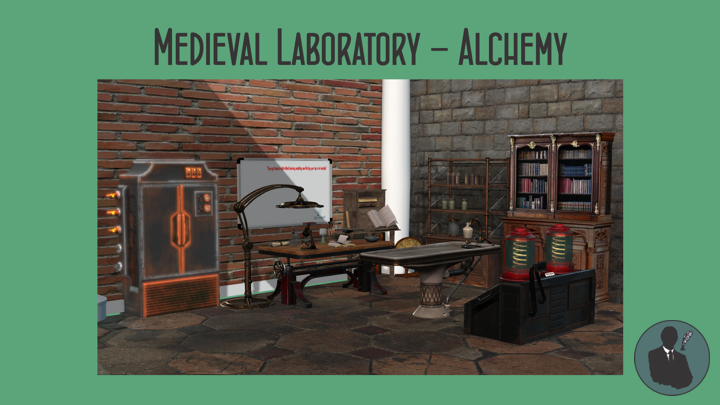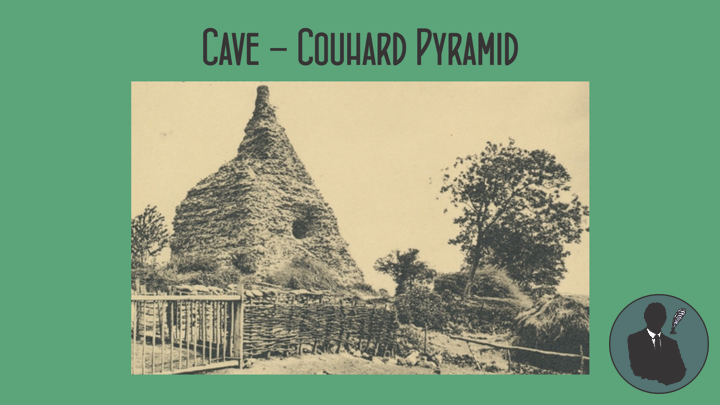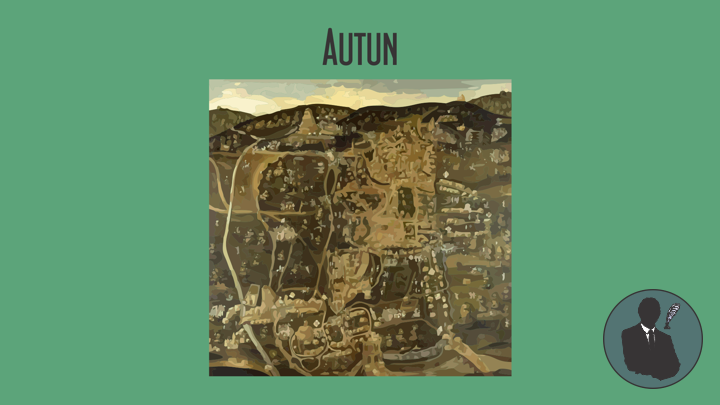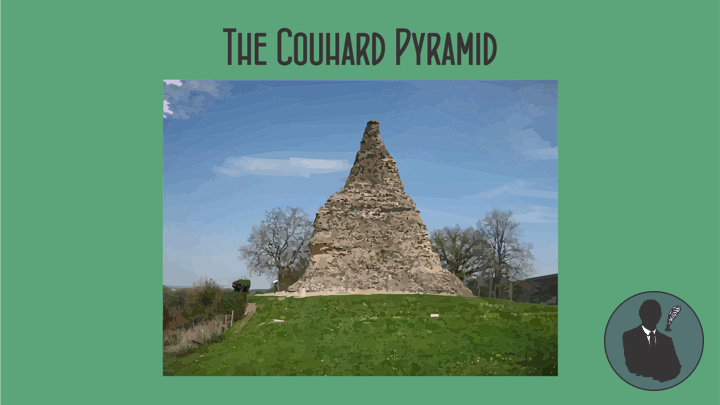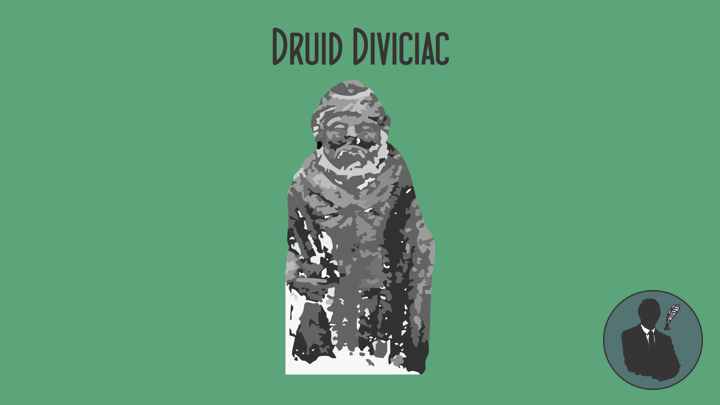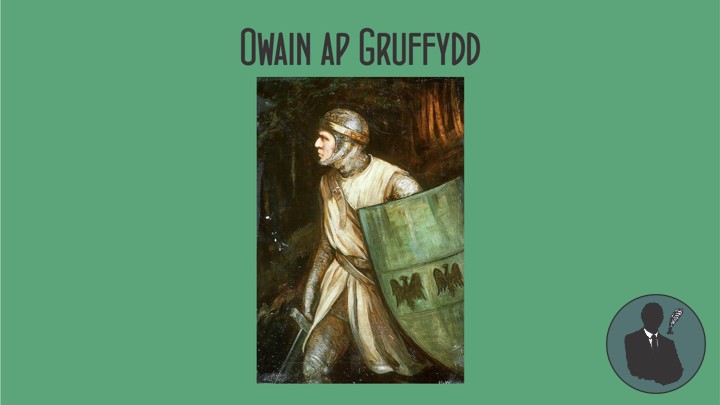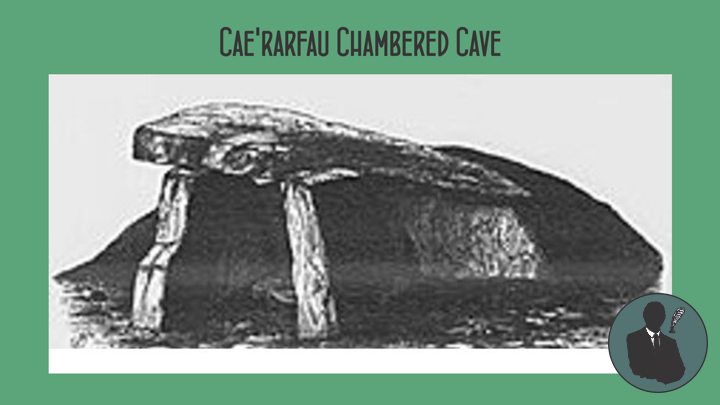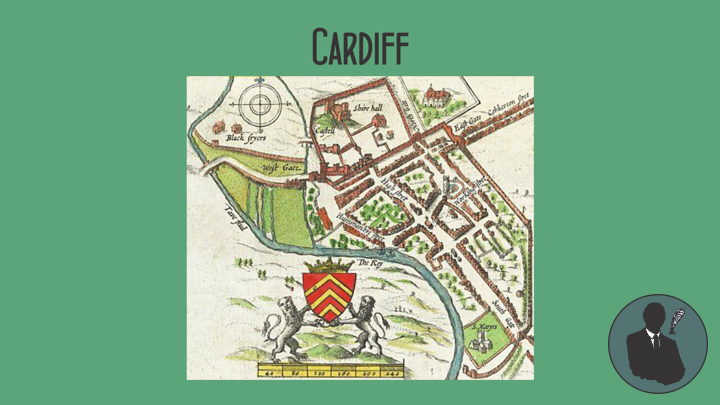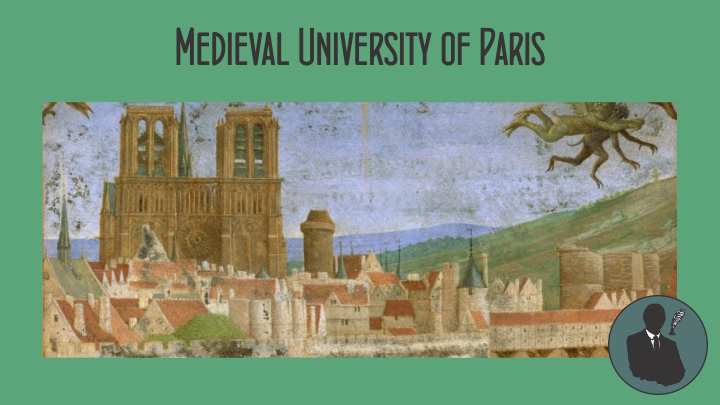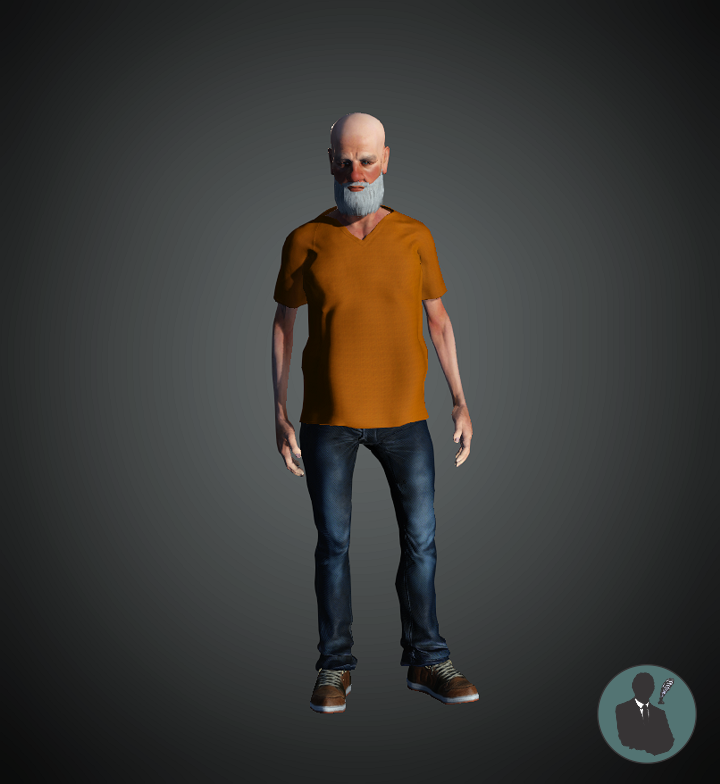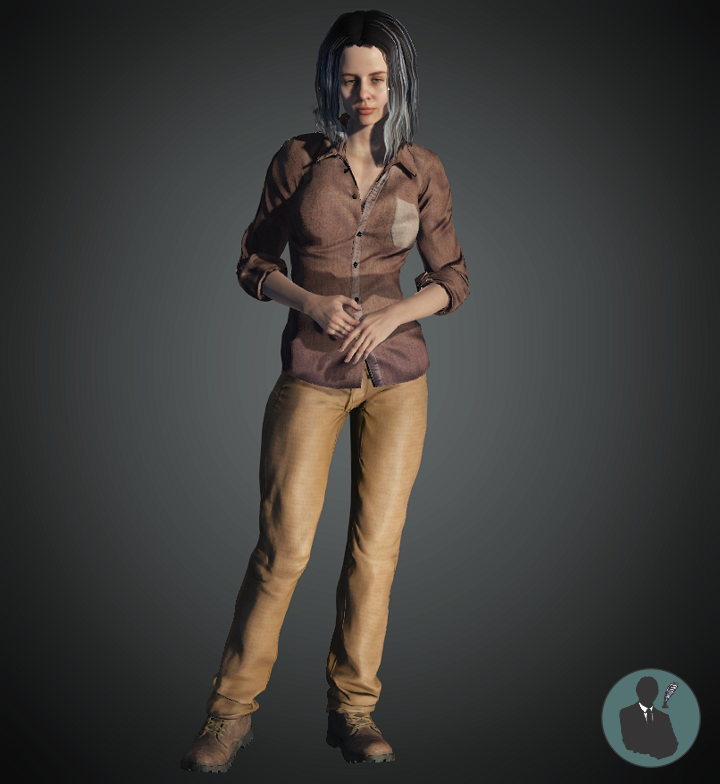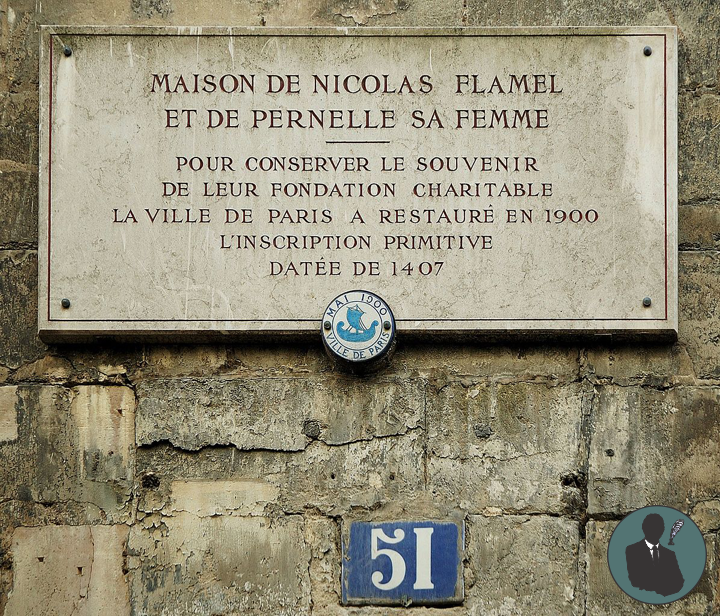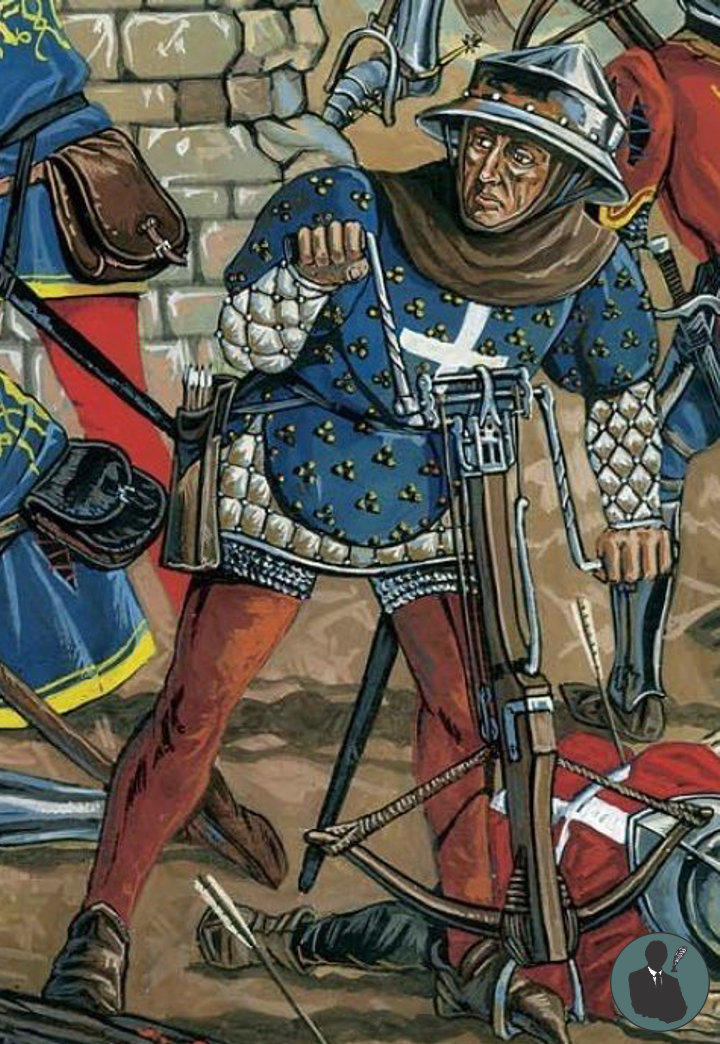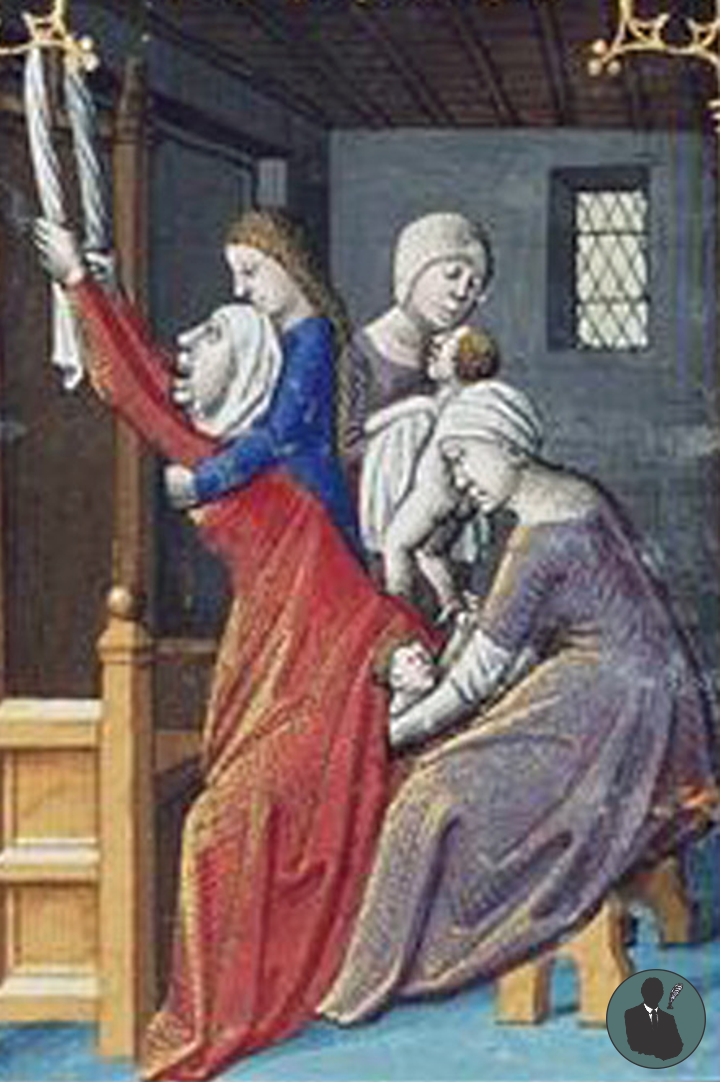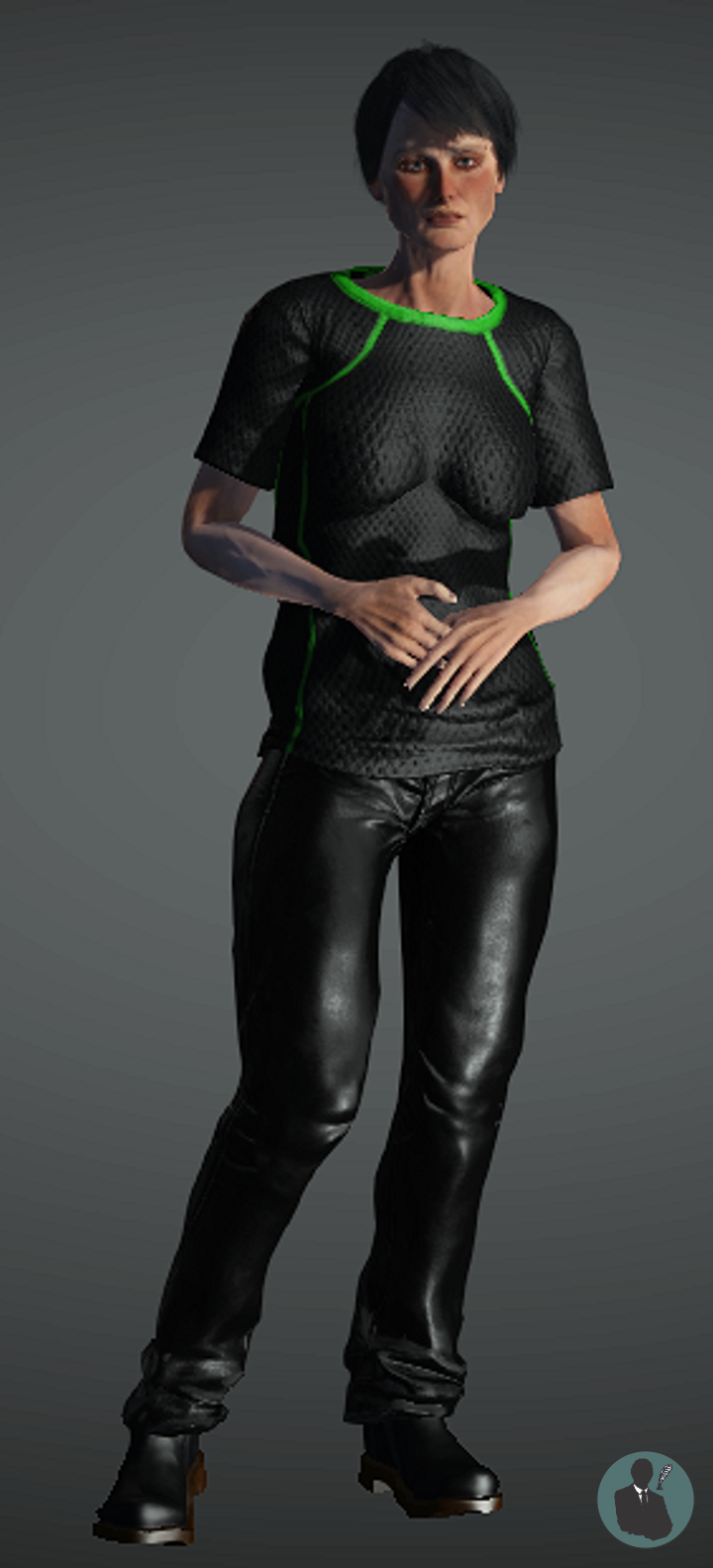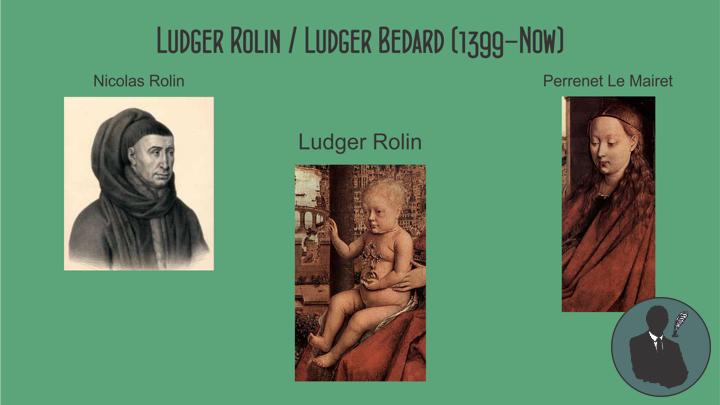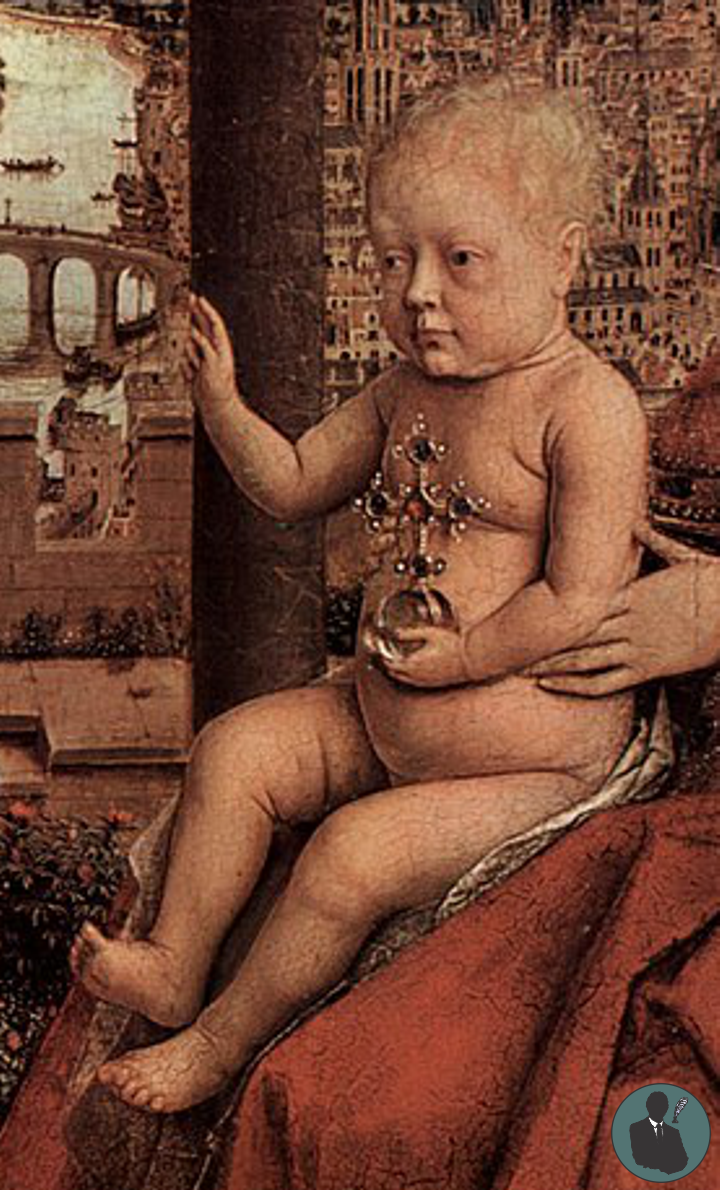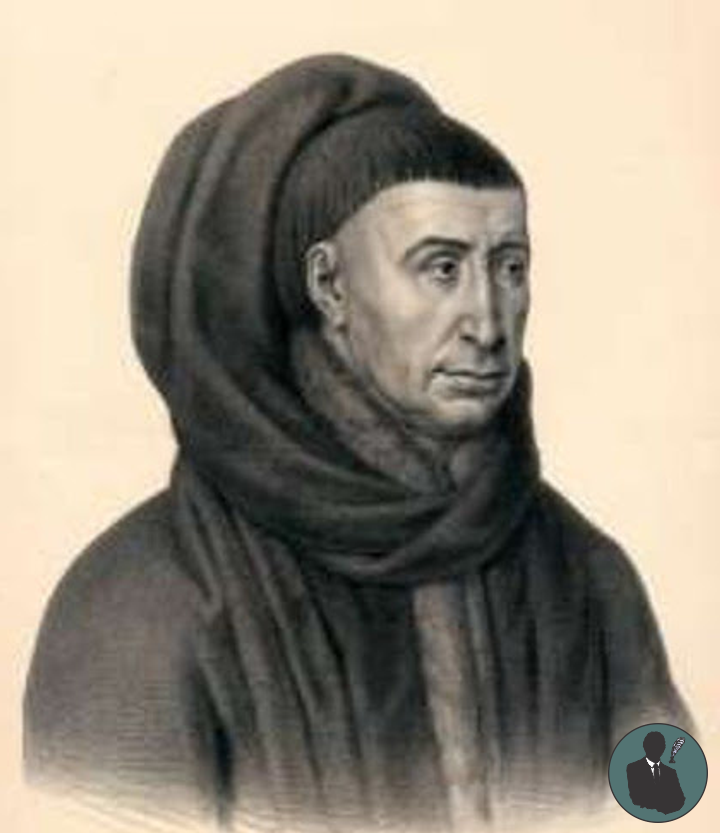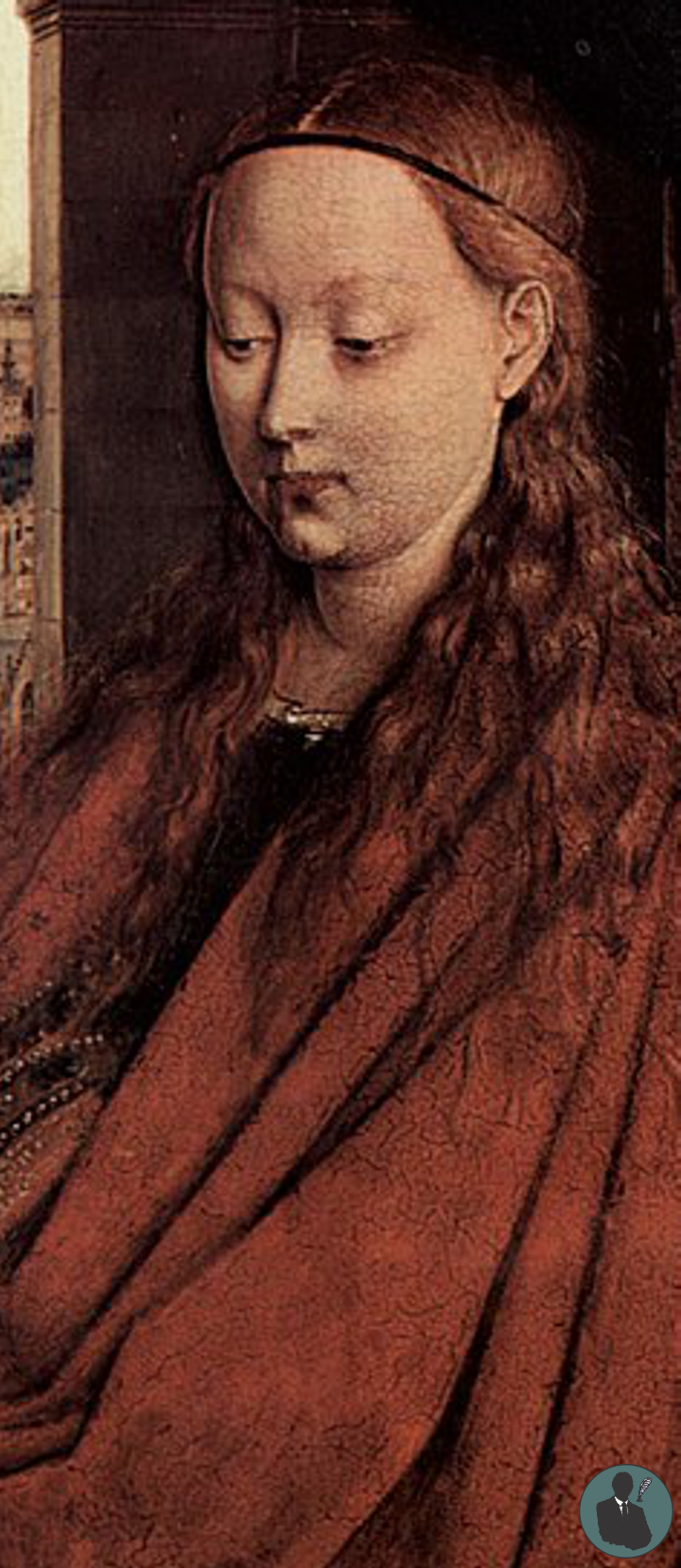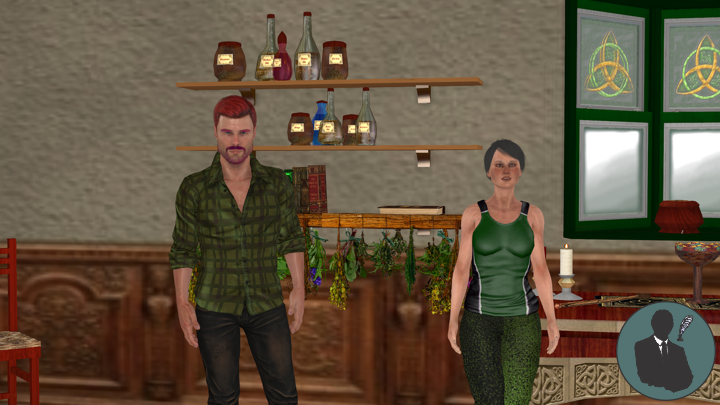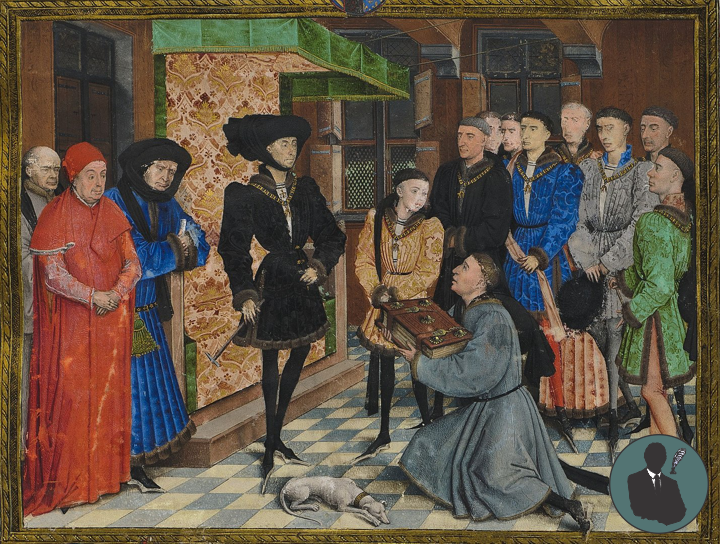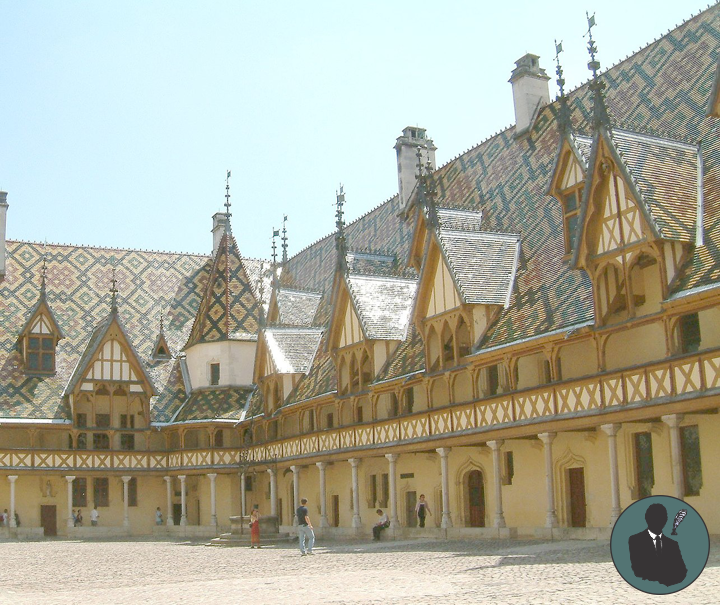Ludger Bedard
——
#LudgerBedardConsultingPrivateDetective #LudgerBedard #NicolasRolin #CouhardPyramid #Laboratory #Alchemy #Detective #Adventurer #Occult #Paranormal #Magic #Alchemy #3DAnimation
——
——
——
Ludger had not been sleeping for more than an hour, when some tremors, affecting the entire cave, awoke him with a start. It felt like an underground rumbling similar to blasting in a mine. He got up, his head throbbing, his knee sore. He looked outside to find out the cause of the commotion. After convincing the horses to cross the cave, they exited by a side tunnel. They made rapid progress, stopping only for short rests. They would not need to follow narrow mountain trails. He was surprised to see the sky lit by some beautiful aurora borealis. The northern lights were dancing in the air making never-ending patterns. He was too tired to admire the spectacle.
Nicolas Rolin
Although his public and lucrative life probably incurred the animosity evident in these comments, they also reflect the rigid social structure of the ducal court; a system contemptuous towards non-nobles, such as Rolin. Rolin spent the majority of his life working for the Valois dukes of Burgundy, and while he was wealthier than many of those with titles around him, he was not noble. Whose famous rivalry with the Rolin family limited and then ended Rolin’s power in the final decade of his life. Battles for status in the hothouse of the Burgundian court system caused the ‘Vulgar Destructive Envy” that marks Rolin’s relationships with his noble contemporaries. He inherited lands in such famous wine-producing areas as Mersault, Auxey, Volnay, Beaune, and Pommard.
Laboratory, Professional Master Chefs, and Wine Burgundy (1480-1530)
Ludger became a noted alchemist of considerable talent, he expanded a collection of recipes, a famous book on cookery and cookery technique, thought to be one of the first professional treatises written in France and upon which the French gastronomic tradition was founded. Managing grapevines can be a surprisingly complicated process, especially when wine production is the end goal. Environmental factors like temperature, soil health, and solar radiation can significantly affect vine performance and fruit quality. Likewise, management-related factors like canopy management, irrigation, planting density, variety and rootstock choice, and site selection play an important role. Plus, grapevines often respond to each of these factors individually, and the interaction of multiple factors can also influence their response.
Ludger Bedard
——
#LudgerBedardConsultingPrivateDetective #LudgerBedard #CouhardPyramid #Cave #MedievalLaboratory #Diviciac #Alchemy #Detective #Adventurer #Occult #Paranormal #Magic #Alchemy #3DAnimation
——
——
Medieval Laboratory – Alchemy
Druid Diviciac of the Aedui tribe who lived in Gaul during the 1st century BC. The name may mean “Avenger”. Julius Caesar, who knew him well, of his knowledge of divination, astronomy and natural philosophy. Druid Diviciac laboratory alchemy has played a significant role in the development of modern chemistry, medicine and psychology.
Alchemy can generally be defined as an ancient art form that seeks purification of the soul and immortality in parallel with the transmutation of chemical elements where gold symbolizes perfection. Alchemists made medicines and pharmaceuticals, and endeavoured to understand the material basis of the world. Although the alchemists practiced actual chemistry and medicine, turning lead into gold symbolized a spiritual transmutation equivalent to an awakened consciousness present in all forms and which created the universe.
Cave
The tunnel opened up into a large cave, lit by an eerie glow. The sight that greeted him, when he entered the cave, crushed the breath right out of his chest. Druid Diviciac laboratory… It was a dark, cluttered, rectangular room, carved out of solid rock, in a keep that was itself carved out of a gigantic monolith, all blackened and cracked as if it had been exposed to tremendous heat and energy. In the middle of this room stood a gray flecked pedestal, hewn from a colossal block of granite. A large hemispherical bowl of black enameled metal, engraved with golden cabalistic signs, sat in a hollow on its polished top. An aura of intense energy surrounded this bowl, and in it a deep blue, shimmering and smoking substance, looking like shiny molten metal, cast eerie lights on to the face in Ludger.
Druid Diviciac his practiced fingers looked like butterflies when they traced arcane symbols in the air over the shimmering surface of the incantation well. After a timeless period of mesmerizing flight, they took a pinch of the orange powder from the little clay pot, and sprinkled it onto the cloudy surface of the liquid. With a hissing sound, and short green flames, the liquid stopped shimmering and cleared itself into a dark, highly polished metallic surface. Pictures started flickering on it. At first stars moving by at a tremendous speed, then a blue ball on a black velvet background, then white puffy high clouds through which the perspective dove on its way to the ground.
He then started chanting a long incantation in a deep droning voice, as his eyes rolled back and his fingers resumed their aerial dance. A green glowing cloud started to collect at the surface of the liquid in the bowl, its Inner Light became brighter to the point that it was painful to look at. Diviciac raised his eyes, deep exhaustion and strain showing. He said in a tired voice, “The Deed Is Done”. As soon as these words escaped his mouth, his huge form gently collapsed to the ground to breathe one’s last breath.
Ludger Bedard
——
#LudgerBedardConsultingPrivateDetective #LudgerBedard #CouhardPyramid #Detective #Adventurer #Occult #Paranormal #Magic #Alchemy #3DAnimation
——
——
Cave – Couhard Pyramid
It was common to travel in heavily loaded: goods, food feed, books, laboratory, glass jars, weapons, tools, tents, clothing, money, documents, etc… Travelling was expensive: suitable and elegant clothing, tolls, tips, lodging, food, veterinaries, etc… To travel, wine was a more recommendable drink than some unsafe water. Ludger a 1457 in Atun at 1 horse and 7 packhorses were used a great deal to carry sacks or baskets filled with goods, slung on either side of the horses.
Suddenly they entered a narrow gorge. The walls were so close that there was just enough room for two horses. There was less snow on the ground, but they could still see the blizzard raging high overhead. It was very cold and damp, but at least they did not have to contend with the high wind and the snow.
After a good hour of slow progress, they finally reached a cirque facing a metal clad door, set in the mountainside. He, alone, proceeded to the door. Ludger the “Magic Tablet” in Couhard Pyramide. He leaned from his mount and grabbed a massive knocker, set in the middle of the door. He slowly pulled away from the door, as it ponderously opened out in silence. The turned his horse quickly disappeared in a side passage leading back into the storm.
The large door closed behind them with a resounding thud. They were in a nondescript dark cave of large proportions. They lit torches and followed one by one. A few torches were smoking on the walls. They were quick to follow him on foot, leading their horses. After the raging blizzard, the tunnels were very comfortable. They were led through a long series of tunnels that ended in a cathedral sized cave with a ceiling so high, that the light from the torch did not reach it. He disappeared in one of the multitudes of openings lining the walls. that haunted the long abandoned mining tunnels.
The tunnels, that they would follow were a veritable maze. Their larger horses barely squeezed through the opening. They lit torches and followed one by one. The tunnel quickly widened and permitted more comfortable progress. After four hours of monotonous progression, they entered a large cavern whose walls were covered in crystals of all colours. The light from the torches was caught and amplified in a stunning kaleidoscope of coloured patterns.
The tunnel opened up into a large cave, lit by an eerie glow. The sight that greeted him, when he entered the cave, crushed the breath right out of his chest. Druid Diviciac laboratory…
Ludger Bedard
——
#LudgerBedardConsultingPrivateDetective #LudgerBedard #CouhardPyramid #Detective #Adventurer #Occult #Paranormal
#Magic #Alchemy #3DAnimation
——
——
——
——
Owain ap Gruffydd, Nicolas, Perenelle, and Anne-Marie to the Cae’rarfau Chambered Cave.
University of Paris, University of Bologna, University of Oxford, University of Vienna, University of Heidelberg, University of Florence, University of Montpellier, University of Angers, University of Cambridge, Etc..
Ludger student could leave the university or pursue further studies in one of the higher faculties medicine, the last one being the most prestigious Doctorate Degree. Him Ludger cover many subjects including medicine, physics, biology, zoology, metaphysics, logic, ethics, aesthetics, poetry, theatre, music, rhetoric, psychology, linguistics, historian, archaeology, economics, politics, meteorology, geology and government.
Autun
Autun knew in the founded by the Romans like Augustodunum, sister and emulator of Rome at the beginning of the reign of the Emperor Augustus, Gallo-Roman capital of the Eduens replacing Bibracte, bishopric from antiquity, autun is until the end of the 15th century a Prosperous city and an influential cultural center, despite looting and invasions.
In Renaissance Europe, philosophical interest in the remains of Greco-Roman civilization and the rediscovery of classical culture began in the late Middle Ages. Ludger, an humanist historian, created a systematic guide to the ruins and topography of ancient Autun in the early for which he has been called an early founder of archaeology.
Couhard Pyramide
This monument was undoubtedly built in the first century. Only the inner block has reached us. It was covered with a regular siding forming a pyramid and reached about 33 meter. The stone stood in one of the great necropolis of the city: the cemeteries of all Roman cities were still outside the walls. The Couhard Pyramide whose interpretation gave rise to many controversies, was therefore most likely a funeral monument: a tomb covering the remains of a deceased, or a cenotaph, celebrating his memory. The old necropolis of the “field of urns” in Autun.
The latter, who hoped to fall on an inner room, found nothing, the building being fills. The monument aroused many recalls that many saw the Druid Diviciac. The basis of the monument is found a “Magic Tablet” lead of the II century with Latin and Greek inscriptions, as well as a large cross.
Druid Diviciac
The druid is inseparable from the history of Gaul; He is part of society. Druid Diviciac stayed in Rome in the 60s-59 BCs. penetrated with Roman culture, he was the friend of Caesar. After these twenty years of training and after receiving a physical and military education, Diviciac was worthy of perpetuating the druidic tradition. The prediction and divination soon have no secrets for him, not more than the thirty-six constellations which, according to the Gauls, governed time and illustrated the conscience of men. We know the fear of the Celts that the sky does not fall on their heads on the head. This fear seems to find his explanation in the importance of these constellations.
Like other druids, Diviciac went to perfect his knowledge in the island of Ogyrie “five days of navigation of Brittany”, an island that had a reputation for being “A Lovely Sweetness”, where the gods were conversing with Humans, where “birds brought to the god ambrosia, where Saturn himself remained in a deep cave and slept under a shiny rock like gold, where the demons that surrounded him possessed the gift of prophecy”, Where the God of Druids made revelations in a dream of his disciples. These having to remain secret according to the druids, allowed knowledge to evolve and rejuvenate. As a druid, Diviciac had not only didactic functions he also exercised a religious, political, military and legal role, while acting on the advice of “Intermediary Between The Gods And Men”.
Ludger the “Magic Tablet” in the year 1457 in Couhard Pyramide in a cave.
Ludger Bedard
——
#LudgerBedardConsultingPrivateDetective #LudgerBedard #AnneMarieBedard #NicolasFlamel #Detective #Adventurer #Occult #Paranormal #Magic #Alchemy #3DAnimation
——
——
——
——
A home laboratory in Nicolas and Ludger a two goals of alchemy: that they made the Philosopher’s Stone, which turns base metals into gold, and that he achieved immortality through the “Elixir of Life”. Ludger a laboratory technician who works in a laboratory performing procedures, maintaining equipment, assisting lead Nicolas with their work. Flamel and Ludger in 1418 created the Elixir of Life that achieved immortality.
Owain ap Gruffydd
Nicolas Flamel a true friend Owain ap Gruffydd up for him. When others try to hurt him emotionally or physically, they do everything they could to make sure he stayed safe. Owain ap Gruffydd, was a Welsh leader who instigated a fierce and long-running war of independence with the aim of ending English rule in Wales during the Late Middle Ages.
Despite the initial success of the revolution, in 1407 the superior numbers, resources and wealth that England had at its disposal eventually began to turn the tide of the war, and the much larger and better equipped English forces began to overwhelm the Welsh and eventually by 1409 they had reconquered most of Wales. Owain ap Gruffydd fought on until he was cornered and under siege at Kidwelly Castle, however he managed to escape capture by disguising himself as an elderly man, sneaking out of the castle and slipping past the English military blockade in the darkness of the night.
Owain retreated to the Welsh wilderness with a band of loyal supporters, he refused to surrender and continued the war with guerilla tactics such as launching sporadic raids and ambushes throughout Wales and the English borderlands. The last documented sighting of him was in 1412 when he ambushed the Kings men in Brecon and captured and ransomed a leading supporter of King Henry’s. He twice ignored offers of a pardon from the new King Henry V of England, and despite the large rewards offered for his capture, Owain ap Gruffydd was never betrayed to the English. The last native Welsh person to hold the title Prince of Wales. Although initially successful, the uprising was eventually defeated, but Owain disappeared and no one knows what became of him after that.
Cae’rarfau Chambered Cave
The monument comprises the remains of a chambered cave, dating to the Neolithic period. Chambered tombs were built and used by communities over long periods of time. Owain ap Gruffydd travels to a wooded valley, and there on a mound, wielding a large knightly sword he finds the keeper. In some retellings the keeper is as an ogre. The keeper is surrounded by wild animals, some magical power. The keeper ridicules Owain, but after enduring his torments, he directs the knight to travel a path out of the woods where he must climb a hill. Over the hill Owain is told he will come to a broad valley where he will find a great tree. Under the tree is a fountain and near the fountain is a marble slab to which by a chain a silver bowl is fastened. Owain is instructed to fill the bowl with water from the fountain and then wet the slab to summon a black knight upon a black steed.
Owain follows the keeper’s directions, and after wetting the marble slab, there is a peal of thunder followed by a terrible hailstorm which nearly kills both Owain and his horse. The weather then clears and birds land on the tree and sing to the knight. Owain is then approached by a figure, who accuses the knight of killing the people and animals of the land who were unable to find shelter in the supernatural hailstorm. Finally the black knight appears and attacks, beating Owain ap Gruffydd with ease, taking his horse and driving him away from the well. Owain walks back to the forest where the keeper awaits, mocking and shaming the defeated knight further. Owain ap Gruffydd returns to the Cae’rarfau Chambered Cave supplying him with a new horse for his journey home.
Paris to Cardiff
It was common to travel in heavily loaded: goods, food feed, books, laboratory, glass jars, weapons, tools, tents, clothing, money, documents, etc… Travelling was expensive: suitable and elegant clothing, tolls, tips, lodging, food, veterinaries, etc… To travel, wine was a more recommendable drink than some unsafe water. Nicolas, Perenelle, Anne-Marie and Ludger a July 1418 and Paris to Cardiff. Paris at 4 horses and 20 packhorses were used a great deal to carry sacks or baskets filled with goods, slung on either side of the horses to 7 days Saint-Malo.
Viking longships were a type of specialized used by the Viking for commerce and exploration. The ship was built with 60 pairs of oars, for a crew of 120 rowers, a rectangular sail, on a single mast and additional crew members, Nicolas, Perenelle, Anne-Marie and Ludger. Sailing used to take place when the sea was the calmest. The driving forces of the ships were rowing and sail this combined with the use of oars. At 10 days trip from Saint-Malo to Cardiff.
Cardiff from Owain ap Gruffydd to Nicolas, Perenelle, Anne-Marie and Ludger to the Cae’rarfau Chambered Cave.
Nicolas Flamel
——
#LudgerBedardConsultingPrivateDetective #LudgerBedard #AnneMarieBedard #NicolasFlamel #MedievalUniversity #Detective #Adventurer #Occult #Paranormal #Magic #Alchemy #3DAnimation
——
——
Meeting of Doctors at the University of Paris
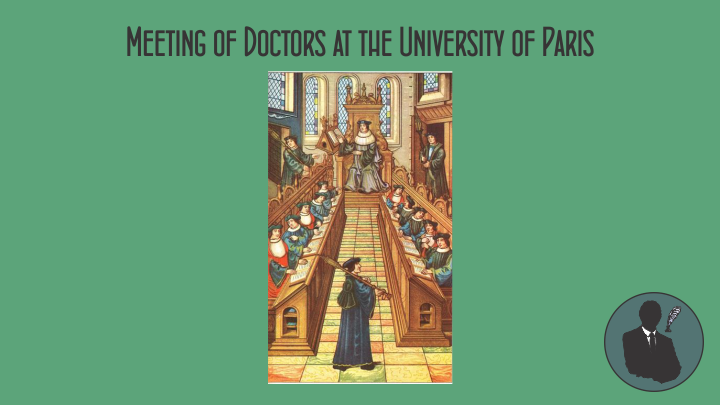
——
Descent of the Holy Ghost Upon the Faithful
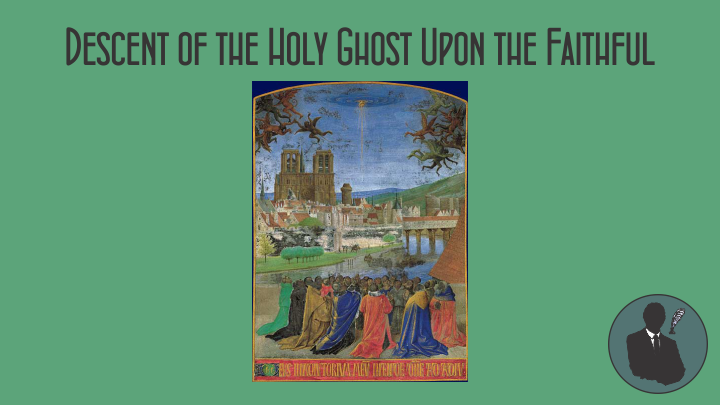
——
Anne-Marie is Ludger a polymath in knowledge covers a substantial number of subjects, known to take advantage of complex knowledge bodies to solve specific problems. Anne-Marie and Flamel is Ludger student attended the medieval university at different ages 8 if they were attending University of Paris. University Ludger studie took 3 years for a Master of Arts degree. Once a Master of Arts degree had been conferred, the Ludger student could leave the university or pursue further studies in one of the higher faculties medicine, the last one being the most prestigious Doctorate Degree.
Medieval University
A medieval university was a corporation organized during the Middle Ages for the purposes of higher education. The first Western European institutions generally considered to be universities were established in the Kingdom of Italy, the Kingdom of England, the Kingdom of France, the Kingdom of Spain, and the Kingdom of Portugal between the 11th and 15th centuries for the study of the arts and the higher disciplines of theology, law, and medicine. During the 14th century there was an increase in growth of universities and colleges around Europe.
The word universitas originally applied only to the scholastic guilds—that is, the corporation of students and masters—within the studium, and it was always modified, as universitas magistrorum, universitas scholarium, or universitas magistrorum et scholarium. Eventually, probably in the late 14th century, the term began to appear by itself to exclusively mean a self-regulating community of teachers and scholars recognized and sanctioned by civil or ecclesiastical authority.
Establishment
Among the earliest universities of this type were the University of Bologna (1088), University of Paris (1150), University of Oxford (1167), University of Modena (1175), University of Palencia (1208), University of Cambridge (1209), University of Salamanca (1218), University of Montpellier (1220), University of Padua (1222), University of Toulouse (1229), University of Orleans (1235), University of Siena (1240), University of Valladolid (1241) University of Northampton (1261), University of Coimbra (1288), University of Pisa (1343), Charles University in Prague (1348), Jagiellonian University (1364), University of Vienna (1365), Heidelberg University (1386) and the University of St Andrews (1413) begun as private corporations of teachers and their pupils.
Course of Study
University studies took six years for a Master of Arts degree. Studies for this were organized by the faculty of arts, where the seven liberal arts were taught: arithmetic, geometry, astronomy, music theory, grammar, logic, and rhetoric. All instruction was given in Latin and students were expected to converse in that language. The trivium comprised the three subjects that were taught first: grammar, logic, and rhetoric. The quadrivium consisted of arithmetic, geometry, music, and astronomy. The quadrivium was taught after the preparatory work of the trivium and would lead to the degree of Master of Arts. The curriculum came also to include the three Aristotelian philosophies: physics, metaphysics and moral philosophy.
Trivium
The trivium is the lower division of the seven liberal arts and comprises grammar, logic, and rhetoric. Grammar, logic, and rhetoric were essential to a classical education, as explained in Plato’s dialogues. The three subjects together were denoted by the word trivium during the Middle Ages, but the tradition of first learning those three subjects was established in ancient Greece.
Quadrivium
The quadrivium followed the preparatory work of the trivium, consisting of grammar, logic, and rhetoric. In turn, the quadrivium was considered the foundation for the study of philosophy and theology. The quadrivium was the upper division of the medieval education in the liberal arts, which comprised arithmetic (number in the abstract), geometry (number in space), music (number in time), and astronomy (number in space and time). Educationally, the trivium and the quadrivium imparted to the student the seven liberal arts (essential thinking skills) of classical antiquity.
Anne-Marie Bedard
——
#LudgerBedardConsultingPrivateDetective #LudgerBedard #AnneMarieBedard #NicolasFlamel #Detective #Adventurer #Occult #Paranormal #Magic #Alchemy #3DAnimation
——
——
——
——
Anne-Marie and child Ludger Bedard here is Paris. She is generally considered one of the first truly professional master chefs. From 1402 – 1407 she was in service to Charles VI. From 1407 she was in service to Nicolas Flamel.
Nicolas Flamel
Nicolas Flamel was a French scribe and manuscript-seller. In his youth in the Pyrenees Mountains of France, and it was there that he met Perenelle, his future wife. Flamel became a noted alchemist of considerable talent. At some point, he created the Philosopher’s Stone, an item of immense magical power. With the Stone, he created the Elixir of Life, a potion that made the drinker functionally immortal as long as it was regularly ingested. He and Perenelle regularly used the potion after that time.
Flamel spent 21 years trying to decipher it all. When Paris couldn’t provide answers, he set off to Spain to find a Jewish scholar and came across Maestro Canches, a learned Jewish man living in Leon. Canches recognised Abraham the Jew as one of the earliest masters of the Jewish mystical tradition of Kabbalah and translated the few pages Flamel had with him before agreeing to travel back to France and translate the rest. Unfortunately, he fell ill on the journey and died before they reached Paris.
He ran two shops as a scribe and married Perenelle in 1368. She brought the wealth of two previous husbands to the marriage. The French Catholic couple owned several properties and contributed financially to churches, sometimes by commissioning sculptures. Later in life, they were noted for their wealth and philanthropy.
Perenelle Flamel (1320 – Now)
Perenelle Flamel was the wife of the famous 14th-century scribe Nicolas Flamel. Perenelle’s reputation as an alchemist stems from a book written in 1612, allegedly authored by her husband. However, Nicolas’ reputation as an author and immortal alchemical. Perenelle figures prominently in the introduction of this Booke of Hieroglyphicall Figures, where the character of Nicolas outlines his quest for the philosopher’s stone. In this story, Perenelle witnesses alchemical projections and aids in chrysopoeia.
House in Paris
One of Flamel’s houses still stands in Paris, at 51 rue de Montmorency. It is the oldest stone house in the city. There is an old inscription on the wall, which states, “We, plowmen and women living at the porch of this house, built in 1407, are requested to say every day an ‘Our Father’ and an ‘Ave Maria’ praying God that His grace forgive poor and dead sinners.”
Philosopher’s Stone
The philosopher’s stone, more properly philosophers’ stone or stone of the philosophers, is a mythical alchemical substance capable of turning base metals such as mercury into gold or silver. It is also called the elixir of life, useful for rejuvenation and for achieving immortality; for many centuries, it was the most sought goal in alchemy. The philosophers’ stone was the central symbol of the mystical terminology of alchemy, symbolizing perfection at its finest, enlightenment, and heavenly bliss.
Anne-Marie Bedard
——
#LudgerBedardConsultingPrivateDetective #LudgerBedard #AnneMarieBedard #Detective #Adventurer #Occult #Paranormal #Magic #Alchemy #3DAnimation
——
Abraham Bedard
——
Guillemette Le Clerc
——
Anne-Marie Bedard
——
Anne-Marie Bedard as born in 1357 in Beaune, Burgundy, France. The daughter of Abraham Bedard and Guillemette Le Clerc, she was the thirteen of their thirteen children. Father Abraham Bedard is French soldiers. Guillemette Le Clerc changing views of medicine caused the women’s role as midwife to be pushed aside as the professionalization of medical practitioners began to go up.
Monks and monasteries of the Roman Catholic Church have had an important influence on the history of Burgundy wine. While single women both lived without a spouse at some point in their lives, their lifestyles were very different and widows were often awarded more freedoms and opportunities. If a woman living did not marry in her teens, she was often expected to join a nunnery.
Le Tart Abbey, was the nunnery of the Cistercian. It was located of Tart-l’Abbaye in Burgundy the Cistercian mother house. Thanks to its support from the upper echelons of society, if not to more popular appeal, the abbey received sufficient endowments to ensure its financial stability through the difficult times to come. Its lands included several vineyards, and the sale of wine was a significant element in the abbey’s economy: five hectares of the Vignoble de Bourgogne, others located at Beaune, Chambolle-Musigny, Morey-Saint-Denis, Chézeaux and Vosne-Romanée.
Abbesses Cistercian are major superiors according to canon law, the equivalents of abbots or bishops. They receive the vows of the nuns of the abbey; they may admit candidates to their order’s novitiate; they may send them to study; and they may send them to do pastoral or missionary, or to work or assist—to the extent allowed by canon and civil law—in the administration and ministry of a parish or diocese. They have full authority in its administration. They may not administer the sacraments, whose celebration is reserved to bishops, priests, namely, those in Holy Orders.
Abbesses Cistercian, Anne-Marie Bedard apprenticeships within these trades were difficult to acquire and were not given formal representation in official records. If a woman was lucky enough to acquire such an opportunity to advance professionally within the trade. The economic difficulties that guilds imposed on unmarried women led many to enter the retail industry.
Anne-Marie Bedard is an important figure in the early history of French cuisine. She was cook to the Nicolas Rolin. His first position was enfant de cuisine to Abbesses Cistercian. From 1372 she was queux, head chef. In 1382 she became squire to the Nicolas Rolin. He is generally considered one of the first truly “professional” master chefs.
She expanded a collection of recipes as Anne-Marie Bedard, a famous book on cookery and cookery technique, thought to be one of the first professional treatises written in France and upon which the French gastronomic tradition was founded. It had an inestimable influence on subsequent books on French cuisine and is important to food historians as a detailed source on the medieval cuisine of northern France.
Anne-Marie Bedard
——
#LudgerBedardConsultingPrivateDetective #LudgerBedard #AnneMarieBedard #LudgerRolin #NicolasRolin #PerrenetLeMairet #Detective #Adventurer #Occult #Paranormal #Magic #Alchemy #3DAnimation
——
Ludger Rolin / Ludger Bedard (1399-Now)
——
Ludger Rolin
——
Nicolas Rolin
——
Perrenet Le Mairet
——
Ludger Bedard and Mom Anne-Marie Bedard
——
Nicolas Rolin also inherited his family’s home in Autun on the Rue de Bancs, which, throughout his long life, remained his primary residence. Anne-Marie Bedard a chef de cuisine is a chef that leads and manages the kitchen and chefs of a Nicolas Rolin. The chef de cuisine is in charge of all activities related to the kitchen, which usually includes creating menus, managing kitchen staff, ordering and purchasing stock and equipment, plating design, enforces nutrition, safety, and sanitation, and ensuring the quality of the meals that are served.
Ludger Rolin as born in 1399 in Autun, Burgundy, France. Ludger, “Enfant Terrible” is a French expression, traditionally referring to a child who is terrifyingly candid by saying embarrassing things to parents or others. Nicolas Rolin and Ludger Rolin to represent the interests of children in cases where the child’s wishes differ from those of either parent. Important burgher of Autun, after practice as lawyer in the Parliament of Paris.
However, the expression has drawn multiple usage in careers of science, art, fashion, music, and other creative arts. In these careers, it implies a successful “genius” who is very unorthodox, striking, and in some cases, offensive, rebellious, usually young and successful person who is strikingly unorthodox, innovative, or avant-garde.
Anne-Marie and child Ludger Bedard a legal guardian in 1401 a person who has the legal authority, and the corresponding duty, to care for the personal and property interests of another person, called a ward. The term in “loco parentis” refers to the legal responsibility of a person to take on some of the functions and responsibilities of a parent. Anne-Marie and child Ludger Bedard here is Paris.
An avid reader from before the time he started formally in school, he has had a lifelong interest in learning. He has always said:
“If you go to bed at night without learning something new that day, your day is not complete.”
Ludger Bedard (1411)
The quintessential “Renaissance Man”, Ludger has always had deep passions for a wide variety of interest for as long as he can remember. He is self-learned on a wide variety of topics, and has developed a series of learning and creative techniques to assist him.
Polymath
A polymath is an individual whose knowledge spans a substantial number of subjects, known to draw on complex bodies of knowledge to solve specific problems. Embodying a basic tenet of Renaissance humanism that humans are limitless in their capacity for development, the concept led to the notion that people should embrace all knowledge and develop their capacities as fully as possible. This is expressed in the term Renaissance man, often applied to the gifted people of that age who sought to develop their abilities in all areas of accomplishment: intellectual, artistic, social, physical, and spiritual.
To have encyclopedic knowledge is to have “vast and complete” knowledge about a large number of diverse subjects. A person having such knowledge is called a human encyclopedia or a walking encyclopedia. The concept of encyclopedic knowledge was once attributed to exceptionally well-read or knowledgeable persons such as Plato, Aristotle, Hildegard von Bingen, Leonardo da Vinci, Immanuel Kant, or G. W. F. Hegel. Tom Rockmore described Hegel, for example, as a polymath and “a modern Aristotle, perhaps the last person to know everything of value that was known during his lifetime.” Such persons are generally described as such based on their deep cognitive grasp of multiple and diverse fields of inquiry—an intellectually exceptional subset of philosophers who might also be differentiated from the multi-talented, the genius, or the “Renaissance man.”
Ludger Bedard Detective
——
#LudgerBedardConsultingPrivateDetective #LudgerBedard #NicolasRolin #HospicesDeBeaune #HundredYearsWar #Detective #Adventurer #Occult #Paranormal #Magic #Alchemy #3DAnimation
——
Nicolas Rolin
The Virgin with Chancellor Rolin
——
Nicolas Rolin
Philip the Good of Burgundy and Courtiers, with Rolin at his right hand.
——
Nicolas Rolin
Hospices de Beaune
——
Nicolas Rolin (1376–1462) was a leading figure in the history of Burgundy and France, becoming chancellor to Philip the Good (Philip III, Duke of Burgundy).
Of bourgeois origins, Rolin was born in Autun in 1376 and baptized in the family church of Notre-Dame du Châtel across the street from his home. Nicolas’s granduncle managed to parlay a small inheritance and some good luck into significant landholdings and his grandfather was a prominent, if not particularly wealthy Autunois. Nicolas’s father was a successful landholder who transformed his financial windfall into good marriages for his sons.
The rents and other income accrued from his properties, most of which were related to viniculture, were substantial enough that he had become fairly prominent by the time of his death in 1389, when he was buried in the Cathedral of Saint Lazare in Autun. Coming into a significant inheritance in his teens, Rolin pursued his studies of law in Avignon as a wealthy young man. He inherited lands in such famous wine-producing areas as Mersault, Auxey, Volnay, Beaune, and Pommard, and his landholdings became even larger following the death of his brother, Jean.
Rolin’s first marriage in 1398 was part of a triple marriage of his widowed mother to a bourgeois of Beaune, accompanied by the marriages of her two sons to two daughters of the bridegroom, Perrenet Le Mairet. However all three of these brides were dead within a few years.
Rolin spent the majority of his life working for the Valois dukes of Burgundy, and while he was wealthier than many of those with titles around him, he was not noble. That at a court where the roturier, whatever his office or wealth, was always second-best to the noble born-and-bred, lesser social origins were an embarrassment which one did not seek to expose or explain at length. Chastelain, a prime example of this himself, reflects the values of the milieu that had adopted him in his aloof treatment of those who climbed the social ladder. Chastelain was a member of the minor nobility with limited financial resources and his position at court may account, at least in part, for his unflattering description of Rolin.
Rolin began his career as a lawyer in the Paris parliament and was quickly made chief legal council for John the Fearless in 1408. He served as a chief legal advisor and as an ambassador for the duke until John’s brutal murder in Montereau in 1419. John’s son, Philip the Good, named Rolin chancellor of Burgundy on December 3, 1422, and with this new title Rolin continued his ascent, soon becoming one of the most important diplomats on the European political stage. Rolin was charged with interpreting, negotiating and enforcing the legal rights and regulations of the duchy as well as oversight of all accounting. He served as keeper of the duke’s seal and was involved in most domestic and foreign affairs of state. Performing this service during the years in which Burgundy’s relations with France and England were particularly strained, Rolin acted as a trusted counselor to Philip the Good, helping him navigate his way through treacherous political waters. Rolin’s third marriage, to Guigone de Salins, was also his most upwardly mobile since the bride was a member of the high nobility. In 1423 or 1424, Philip the Good knighted Rolin, and Guigone was made a member of the duchess’s court.
Hospices de Beaune
The Hospices de Beaune or Hôtel-Dieu de Beaune is a former charitable almshouse in Beaune, France. It was founded in 1443 by Nicolas Rolin, chancellor of Burgundy, as a hospital for the poor. The original hospital building, the Hôtel-Dieu, one of the finest examples of fifteenth-century Burgundian architecture.
The Hôtel-Dieu was founded on 4 August 1443, when Burgundy was ruled by Duke Philip the Good. The Hundred Years’ War had recently been brought to a close by the signing of the Treaty of Arras in 1435. Massacres, however, continued with marauding bands till roaming the countryside, pillaging and destroying, provoking misery and famine. The majority of the people of Beaune were destitute, and the area had recently suffered an outbreak of plague. Nicolas Rolin, the Duke’s Chancellor, and his wife Guigone de Salins, responded by building a hospital and refuge for the poor. Having gained permission from Pope Eugene IV in 1441, the hospice was built and consecrated on 31 December 1452. In conjunction, Rolin established the “Les sœurs hospitalières de Beaune” religious order.
Ludger Bedard
